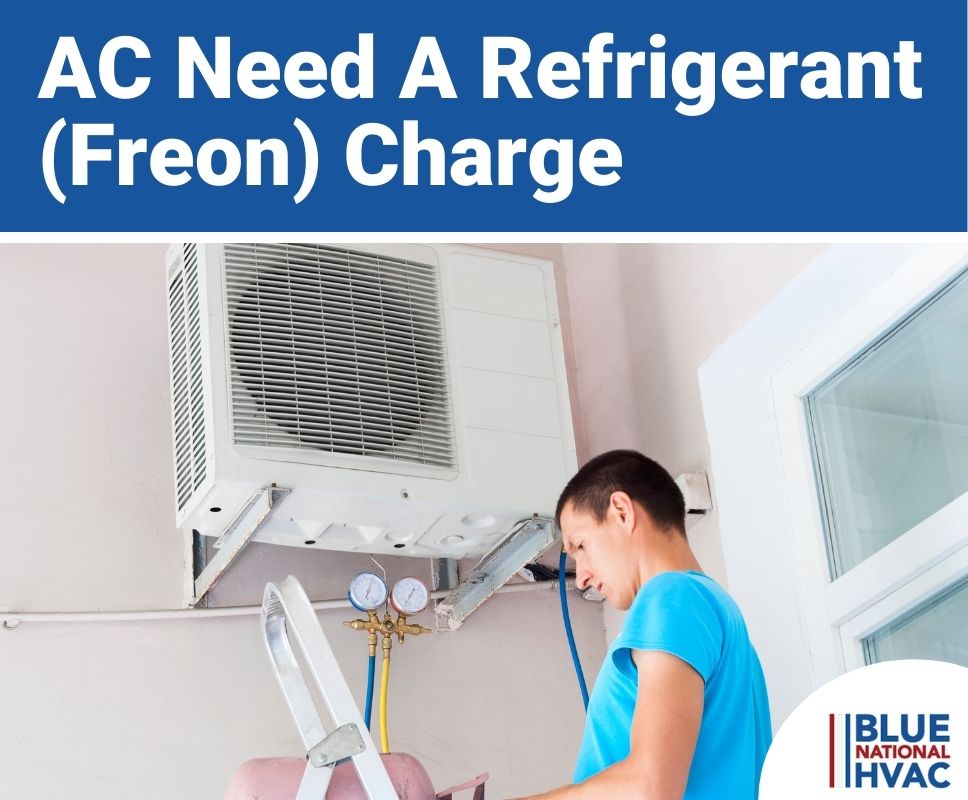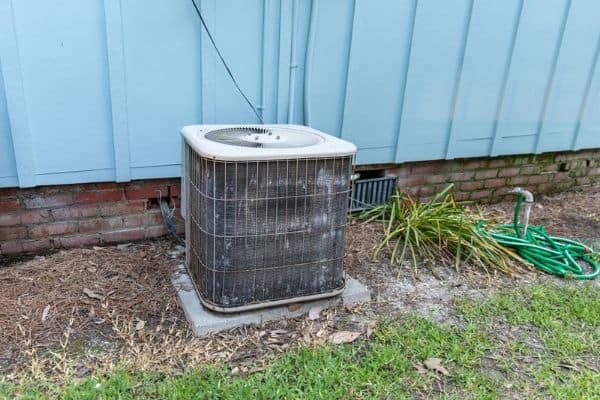Contents (Click To Jump)
- 1 What Are The Signs Of Mold In ACs?
- 2 What Areas In The Central AC Are Most Susceptible To Mold Growth?
- 3 What Causes Mold To Grow In Air Ducts
- 4 DIY: How To Remove Mold From Your HVAC System
- 5 How To Prevent Future Mold Build-Up In Your Central AC?
- 6 Why Should You Seek The Help Of A HVAC Professional?
What Are The Signs Of Mold In ACs?
Air conditioners are your best bet to having a cool home during the summer. However, it doesn’t provide cooling without getting dirty and wet along the way. It accumulates dust and moisture during operation and this combination can quickly turn into a breeding ground for black mold.
When mold runs rampant in your AC system, it could lead to severe respiratory illness, skin reactions, and eye irritation. It can even cause asthma attacks and flare-ups. At the minimum, it could make your home smell “weird.”
To avoid these mold-related health issues, homeowners should know the signs of mold infestation in your AC unit, and how to counteract them.
Here are some common signs of mold growth in your air conditioning system.
Bad Smell
Your air conditioner should emit odorless and clean air under normal circumstances. If a musty smell reeks from your cooling unit, that is the first indication of mold. Mold has a unique musty odor that is very unpleasant and noticeable.
If you notice the pungent mold smell in your home, especially when the air conditioner is running, it is more than likely caused by black mold growing in the ductwork or inside the AC unit.
Respiratory Distress
Mold and mildew can prompt several respiratory issues and allergic reactions. If you feel respiratory distress such as sneezing, coughing, etc., while your air conditioner runs, it could be due to mold. This might be more apparent if you often feel under the weather at home but get better when you’re away for the weekend.
If mold growth is left unresolved, occupants may have an asthma attack or any other respiratory problems.
Constant Colds and Sinus Infections
If you are constantly sick with head colds and sinus infections, that could also indicate prolonged mold exposure. Spores can make their way to your sinus cavities when you breathe in moldy air and cause inflammation as your immune system attacks foreign bodies.
And since you are constantly breathing in new mold spores, your sinus infection and head cold could remain constant too.
That is until you check your cooling unit to determine if there’s a mold infestation.
Dry or Itchy Skin
Skin rashes and dry and itchy skin can develop from black mold exposure. Rashes associated with mold are pretty similar to other rashes and can either be concentrated in one area or occur in different places all over your body.
Mold-causing rashes have symptoms that include discoloration, itching, sensitivity, patches of scaly and dry skin, and bumpy textures.
If you have these symptoms, immediately go to your doctor and check your air conditioning unit for mold.
Headaches and Fatigue
On their own, fatigue isn’t a symptom of mold exposure. However, mold might be the culprit if you have prolonged fatigue with other symptoms such as respiratory tract infections or sinus inflammation.
Mold is Visible
Mold has the characteristic look of a spreading black dot pattern. Visible mold resembles black dots that can be large or small, and can spread quickly.
If you notice these black specks around windows, air vents, ductwork, or inside your air conditioner, you should clean it right away or hire a professional mold remediation service.
What Areas In The Central AC Are Most Susceptible To Mold Growth?
Mold can grow on almost any surface in the HVAC system. However, the places that harbor mold growth most often are the ductwork, drain pan, evaporator coils, and more.
These sites actively support mold growth because they provide the ideal moisture levels, nutrients, and temperatures that mold loves. Mold doesn’t need many nutrients to grow.
Mold feeds on small biomatter floating through the air, which we simply refer to as dust. This gives a whole new meaning to “another one bites the dust.” Removing the mold’s primary source of food is why you should clean your HVAC system regularly.
Here are the details on common areas in your HVAC system that can develop a mold problem.
Evaporator Coils
When your air conditioner is running, it blows warm air across the cold evaporator coils in your indoor unit (air handler). As the heat from the air transfers to the cold refrigerant inside the coils, it also removes excess humidity.
Moisture condenses on the coils, which then drips into the condensate pan. However, if your evaporator coils are covered in dust, mold may make a home there. To prevent dust from building up on your evaporator coils, regularly replace your air filter and clean them once or twice a year.
Condensate Drain Pan and Drain Line
During regular operation, the condensate drain pan of your air conditioner collects the condensation from the evaporator coils. If your coils are dirty, the moisture could bring enough dust with it to fuel the growth of mold.
At the right temperature, the mold could successfully grow and reproduce in the drain pan and drain line.
Ductwork
Other potential areas for mold growth include the air handler cabinet insulation, the ductwork insulation of your air conditioner, and the inside of your HVAC ducts. These areas could all accumulate the perfect mixture of dust and moisture that mold loves.
The ductwork is vulnerable to moisture accumulation from coil blow-off, pipe sweating, and drain pan overflow.
What Causes Mold To Grow In Air Ducts
Mold needs an ideal temperature, moisture conditions, and a good source of organic material to form. Unfortunately, these types of conditions are common inside your ductwork. If a mold spore enters your home and finds these conditions within your air ducts, it will nestle in and begin replicating.
Moisture
When your air conditioner removes heat from the air and cools your home, it also removes humidity from the circulating air. If the incoming air is too humid, your AC unit might not be able to remove enough of the moisture from the air. As a result, the excessively moist air could lead to moisture buildup in the ducts.
Alternatively, your AC unit could develop an issue that leads to high moisture. In either case, this extra moisture could create a breeding ground for mold. If you notice excessive moisture in your supply air, give our team of HVAC experts a call today for support.
Temperature
Mold survives best at temperatures above 40°F and below 100ºF. Since the air in your home is almost always between these temperatures to keep you comfortable, mold will also find comfort within your HVAC system.
Nutrients
Organic matters, including dust, dander, and pet hair, are potential food sources for fungi, bacteria, and mold. This organic matter usually enters the air conditioner through the return and supply vents of your home. Every time your AC runs, it essentially provides the mold with a conveyor belt of food.
DIY: How To Remove Mold From Your HVAC System
Before you spend a lot of time deep cleaning your HVAC system, you can verify that you indeed have mold by testing it. However, a mold infestation is evident most of the time, and you shouldn’t require any testing.
If your mold infestation isn’t too large and easy to access, you can clean it yourself and save substantial money. Alternatively, you can hire mold removal experts or give our team of HVAC technicians a call for help.
Follow the steps below to clean out your mold-infested HVAC system.
Make or Buy a Mold Removal Spray
Making a mold cleaner is relatively easy. For porous surfaces, use a mixture of ½ cup of baking soda, a tablespoon of household dish soap, and one cup of water. For nonporous surfaces, mix 16 parts water with 1 part bleach.
Add your mold removal solution to a spray bottle to make your mold extinguishing job easier.
Alternatively, you could also buy an EPA-approved mold cleaner and inhibitor if you don’t mind spending some money.
Wear Protective Clothing
It’s essential to protect yourself from mold cleaning chemicals as they can be toxic. The Environmental Protection Agency (EPA) recommends wearing rubber gloves, an N95 face mask, protective eyewear, and coveralls.
Turn Your HVAC System Off
First things first – turn off your HVAC system before you start the cleaning. This will give you safe access to your air ducts, drip pan, and evaporator coils without the surprise of a blast of moldy air in your face.
Remove the Mold
Scrub and Vacuum
Soak all moldy areas in your vent opening and ducts with the mold removal solution for around 5 minutes. After soaking, use rags or a brush to scrub the site and remove the mold. Afterward, soak up any excess solution using paper towels and water.
For extra precaution, vacuum the area after cleaning. Get rid of the mold removal rags and disposable air filters by double-bagging them in a thick trash bag. Make sure you clean all registers and vent covers before replacing.
Rent a Mold Removal Fogger Machine
You can buy or rent a mold fogger from most hardware stores. The fogger atomizes a mold control chemical into the air as a mist to achieve a uniform surface application.
Cover all the vents in your house when you pump the mold removal fog into your ductwork. You can cover your vents using masking tape or small cut-out pieces of cardboard. Ensure the only vent you leave open is the one that you use to pump in the fog.
Apply the Mold Inhibitor
After cleaning the ductwork, apply the mold inhibitor to the surfaces of your HVAC system that had mold. Make sure you read and carefully follow the manufacturer’s instructions when using the mold inhibitor. The mold inhibitor will prevent the mold from coming back.
Install New Filters
Replace the old filters after you finish cleaning. The filter may still contain active mold spores.
Look Out for a Mold Resurgence
After you clean everything, apply a mold inhibitor, then keep an eye out for new mold growth for the next few weeks.
If the mold keeps coming back, consult with one of our professionals to check your HVAC system for hidden mold or other moisture problems that need repair.
How To Prevent Future Mold Build-Up In Your Central AC?
Prevention will always be better and less costly than mold removal from your HVAC system. You can take various measures to prevent the spread and growth of mold in your air conditioner, which we detail below.
Air Filters
You should use air filters with a rating of MERV 8 or higher in your HVAC system. Also, ensure that you maintain and regularly replace these air filters when they get dirty.
Depending on your specific filter and how dusty your home is, you should replace it every three to twelve months. A good rule of thumb is to replace it every six months.
Air filters with a rating of MERV 8 or higher have a mesh size that can capture most mold spores. However, as the filters clog, they get less effective at stopping mold.
Routine Maintenance
Routine maintenance is critical to the health and lifespan of your HVAC system. Maintenance can also catch and fix issues that could lead to mold growth early on before they become a big problem.
Schedule bi-annual appointments with our HVAC technicians to perform a tune-up and ensure your system is mold-free. We will check and verify that all major components are working correctly and are clean during our maintenance calls. We will also flush out your condensate drain line to get rid of clogs and dust build-up that could cause mold growth.
Duct Cleaning
Hair, dander, dust, and various pollutants can collect inside your ductwork over time. These pollutants tend to serve as a source of nutrients to mold spores while also reducing indoor air quality and inhibiting airflow. Clean your ducts regularly to get rid of these pollutants and prevent mold.
Install a UV Air Purifier
UV air purifiers are indoor air quality systems that effectively kill and eradicate harmful contaminants such as mold spores, bacteria, viruses, and other germs. The UV light breaks down and kills these pathogens, making them unable to reproduce and preventing their spread.
Why Should You Seek The Help Of A HVAC Professional?
Our experienced HVAC technicians can quickly diagnose the reason mold is forming within your HVAC cooling system.
Usually, mold growth is due to performance issues or a failing component with the air conditioner. If you believe you have mold issues in your air conditioner unit, give our team a call today, and we’ll make you mold-free in no time.









